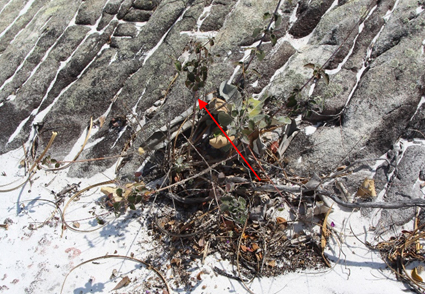Abstract
Recent field expeditions in Campo Rupestre in northern Minas Gerais have been carried out and led to the collection of Hypenia with unusual morphology. After detailed morphological and taxonomic analysis we propose it as a new species of Hypenia based on morphological evidence. We described, illustrated, and the affinities between the most similar species are discussed.
References
- Antar, G.M., Harley, R.M., Pastore, J.F.B., Verdi, M. & Soares, A.S. (2024) Eplingiella sanoi sp. nov. (Hyptidinae—Lamiaceae): supports the urgent need for campos rupestres conservation in the Serra do Espinhaço Septentrional, Minas Gerais state, Brazil. Webbia 79 (2): 191–200. https://doi.org/10.36253/jopt-15902
- Atkinson, R. (1998) A taxonomic revision of Hypenia (Mart. ex Benth.) Harley (Labiatae). Ph.D. Dissertation. University of St. Andrews, Scotland, 293 pp.
- Bachman, S., Moat, J., Hill, A., de la Torre, J. & Scott, B. (2011) Supporting Red List threat assessments with GeoCAT: geospatial conservation assessment tool. ZooKeys 150: 117–126. https://doi.org/10.3897/zookeys.150.2109
- Colli‐Silva, M., Vasconcelos, T.N. & Pirani, J.R. (2019) Outstanding plant endemism levels strongly support the recognition of campo rupestre provinces in mountaintops of eastern South America. Journal of Biogeography 46: 1723–1733. https://doi.org/10.1111/jbi.13585
- Coutinho, L.M. (1990) Fire in the ecology of the Brazilian cerrado. In Fire in the tropical biota: ecosystem processes and global challenges. Berlin, Heidelberg, Springer Berlin Heidelberg, pp. 72–105. https://doi.org/10.1007/978-3-642-75395-4_6
- da Silva-Luz, C.L., Gomes, C.G., Pirani, J.R. & Harley, R.M. (2012) Flora da Serra do Cipó, Minas Gerais: Lamiaceae. Boletim de Botânica da Universidade de São Paulo 30 (2): 109–155. https://doi.org/10.11606/issn.2316-9052.v30i2p109-155
- Echternacht, L., Trovó, M., Oliveira, C.T. & Pirani, J.R. (2011) Areas of endemism in the Espinhaço range in Minas Gerais, Brazil. Flora-Morphology, Distribution, Functional Ecology of Plants 206 (9): 782–791. https://doi.org/10.1016/j.flora.2011.04.003
- Faria, M.T. (2024) Hypenia. In: Flora e Funga do Brasil. Jardim Botânico do Rio de Janeiro. Availabe from: https://floradobrasil.jbrj.gov.br/FB8169 (accessed 7 September 2024)
- Harris, J.G. & Harris, M.W. (2001) Plant identification terminology: an illustrated glossary. Spring Lake Publishing, Payson, Utah, 206 pp.
- Harley, R.M., Atkins, S., Budantsev, A.L., Cantino, P.D., Conn, B.J., Grayer, R., Harley, M.M., de Kok, R., Krestovskaja, T., Morales, R., Paton, A.J., Ryding, O. & Upson, T. (2004) Labiatae. In: Kadereit, J.W. (Eds.) Flowering Plants · Dicotyledons. The Families and Genera of Vascular Plants, vol 7. Springer, Berlin, Heidelberg. https://doi.org/10.1007/978-3-642-18617-2_11
- Harley, R. (1991) The greasy pole syndrome. In: Huxley, C.R. & Cutler, D.E. (Eds.) Ant-Plant Interactions. Oxford University Press, Oxford, United Kingdom, pp. 430–433. https://doi.org/10.1093/oso/9780198546399.003.0028
- Harley, R.M., Giulietti, A.M., Abreu, I.S., Bitencourt, C., Oliveira, F.F. & Endress, P.K. (2017) Resupinate Dimorphy, a novel pollination strategy in two-lipped flowers of Eplingiella (Lamiaceae). Acta Botanica Brasilica 31: 102–107.
- Magri, R., Cabral, A., Prado, J. & Lopes, J. (2024) Two new critically endangered species of Vellozia (Velloziaceae) from the Campos Rupestres of Espinhaço Range, Brazil. Phytotaxa 652 (1): 1–9. https://doi.org/10.11646/phytotaxa.652.1.1
- MapBiomas (2024a) Collection 3 of the MapBiomas Fire. Available from: https://code.earthengine.google.com/?scriptPath=users%2Fmapbiomas%2Fuser-toolkit%3Amapbiomas-user-toolkit-fire.js (accessed 9 September 2024) https://doi.org/10.58053/MapBiomas/XUFVIC
- MapBiomas (2024b) Collection 9 of the Annual Series of Land Use and Coverage Maps of Brazil. Available from: https://code.earthengine.google.com/?accept_repo=users/mapbiomas/user-toolkit (accessed 9 September 2024) https://doi.org/10.58053/MapBiomas/XXUKA8
- Martínez-Gordillo, M. & Valencia-Ávalos, S. (2009) Una nueva especie de Hypenia (Lamiaceae) de México. Brittonia 61: 67–70. https://doi.org/10.1007/s12228-008-9069-1
- Mittermeier, R.A., Turner, W.R., Larsen, F.W., Brooks, T.M. & Gascon, C. (2011) Global biodiversity conservation: the critical role of hotspots. In: Biodiversity hotspots: distribution and protection of conservation priority areas Berlin, Heidelberg, Springer, Berlin, Heidelberg, pp. 3–22. https://doi.org/10.1007/978-3-642-20992-5_1
- Nascimento, D.T.F., Araújo, F.M. & Ferreira Júnior, L.G. (2010) Análise dos padrões de distribuição espacial e temporal dos focos de calor no bioma Cerrado. Revista Brasileira de Cartografia 63, 461–475. https://doi.org/10.14393/rbcv63n4-49215
- Perrino, E.V., Wagensommer, R.P., Mezzapesa, G.N. & Trani, A. (2024) Stachys italica Mill.: synecology, functional compounds and potential use of an Italian endemic taxon. Planta 260: 138. https://doi.org/10.1007/s00425-024-04571-3
- Radford, A.E., Dickson., W.C., Massey, JR. & Bell, C.R. (1974) Vascular Plant Systematics. Harper & Row, New York, Evanston, San Francisco & London.
- Riano, T.R. & Dafni, A. (2006) Pollen-Stigma Interference in Two Gynodioecious Species of Lamiaceae with Intermediate Individuals. Annals of Botany 100: 423–431. https://doi.org/10.1093/aob/mcl168
- Selvi, S., Polat, R., Çakilcioğlu, U., Celep, F., Dirmenci, T. & Ertuğ, Z.F. (2022) An ethnobotanical review on medicinal plants of the Lamiaceae family in Turkey. Turkish Journal of Botany 46 (4): 283–332. https://doi.org/10.55730/1300-008X.2712
- Spréa, R.M., Caleja, C., Pinela, J., Finimundy, T.C., Calhelha, R.C., Kostić, M., Sokovic, M., Prieto, M.A., Pereira, E., Amaral, J.S. & Barros, L. (2022) Comparative study on the phenolic composition and in vitro bioactivity of medicinal and aromatic plants from the Lamiaceae family. Food Research International 161: 111875. https://doi.org/10.1016/j.foodres.2022.111875
- Silva, D.N.D., Antonicelli, M.D.C.A. & Guimarães, P.J.F. (2023) Taxonomic Novelties from the Espinhaço Septentrional: Two New Species of Pleroma and the First Records of Melastomataceae from the Morro das Marombas, Minas Gerais, Brazil. Systematic Botany 48 (1): 44–54. https://doi.org/10.1600/036364423X16758873924090
- Simon, M.F. & Pennington, T. (2012) Evidence for adaptation to fire regimes in the tropical savannas of the Brazilian Cerrado. International Journal of Plant Sciences 173 (6): 711–723. https://doi.org/10.1086/665973
- Stearn, W.T. (2004) Botanical Latin. 4 ed. Timber Press., Portland. 560 pp.
- Thiers, B.M. (2024 [updated continuously]) Index Herbariorum. Available from: https://sweetgum.nybg.org/science/ih/ (accessed 1 September 2024)
- Zavatin, D.A., Almeida, R.B.P., Ramos, R. & Lombardi, J.A. (2023) Chionanthus monteazulensis (Oleaceae), a new species from the campo rupestre of Espinhaço Range, Brazil. Phytotaxa 603: 289–296. https://doi.org/10.11646/phytotaxa.603.3.8
- Zavatin, D.A., Ramos, R., Salimena, F.R.G. & Cardoso, P.H. (2024) A new species of Lippia (Verbenaceae) from the Espinhaço Range, Minas Gerais, Brazil. Acta Botanica Brasilica 38: e20240024. https://doi.org/10.1590/1677-941x-abb-2024-0024


